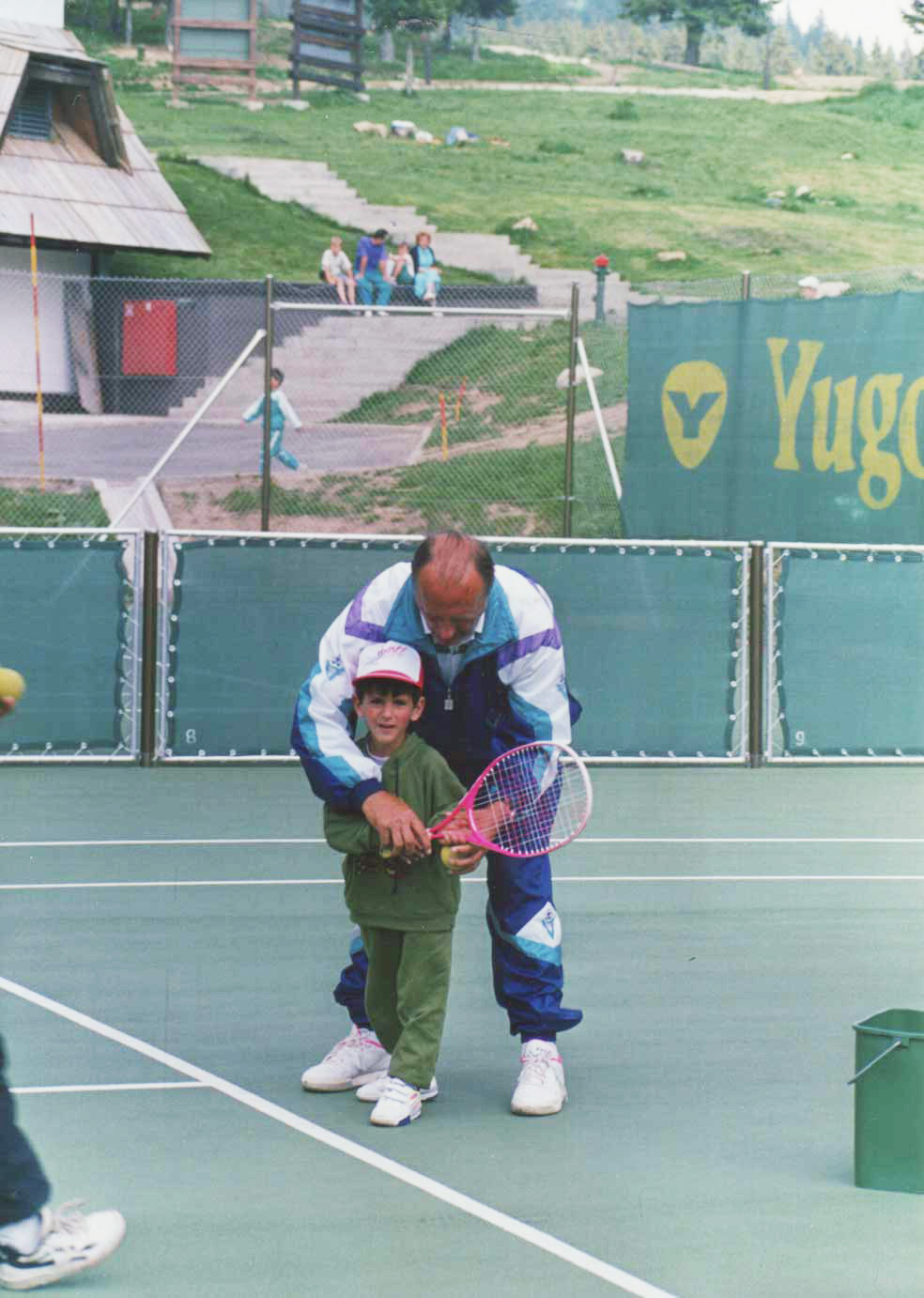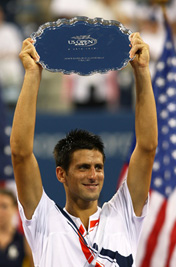Novak Djokovic( Serbian: Новак Ђоковић or Novak Đoković ) ( PART 2 )
 •
by
•
by Apress

The best tennis player in the world, Novak Djokovic, took a racquet in his hands for the first time when he was four years old. It was summer, and one of the best tennis coaches Jelena Gencic, was holding a training camp. Every day Novak came by and watched the trainings. Then, one day, Jelena invited him on court. He accepted, and started playing tennis.
“I knew he would become a champion. It was crystal clear to me. He was focused, conscientious, and above all, talented.” – Jelena Gencic
Although he enjoyed skiing, and even football, it was tennis that won him over – as well as Pete Sampras whose game on the court Novak fully absorbed.
“It was destiny. If something in your life is meant to be, then it’s meant to be!” – Novak Djokovic
1999
While still in elementary school, instead of staying in schoolyard to play with other kids, Novak was running back home to get ready for his tennis sessions. Rain, snow or holidays – nothing could have stopped him from hitting balls with his tennis coach, Jelena. In one moment, when he made an enormous move forward, Jelena advised Novak’s parents: “If you want him to keep progressing, he has to leave the country”.
At that time, a difficult economic and political situation was looming over Serbia. The decision to let Novak move to Germany was difficult, but it was the only logical thing to do. As a 13-year-old boy, Novak went to Munich, to train at the academy run by renowned tennis coach Nikola Pilic.
“From the first day Novak arrived to the camp it was amazing how focused on tennis he was. I never liked predicting if someone would succeed or not, but with Novak I knew he would be the best.” – Nikola Pilic
During the next four years, Novak traveled from Serbia to Niki Pilic Tennis Academy to practice. The first year he went to Germany he stayed there for two months, then the next three months he was back at home in Serbia, and then again he went back to Germany for a month. Going back and forth as a way of living went on for some time until he started achieving great results on the court.
2001
Golden year for, at that time, 14-year-old Novak. He ended the year as a triple European champion in singles, doubles and in team competition – while also winning the silver medal at the World Junior Championship in a team competition for Yugoslavia.
2002
Novak Djokovic became the European champion in a category under 16 years. He won prestigious tournaments such as: “La Boule” and “La Poet” in France, Prince’s Cup in Miami under 18, as well as ITF tournament in Pancevo, where he beat rivals who were up to three years older than him.
After five ITF tournaments he played, Novak became 40th best junior tennis player in the world.
2003
The season began for Novak with the finals at the ITF tournament in Nurnberg. Djokovic then went on to win another gold medal for his country. In the French city of Latne he competed together with his teammates, under the leadership of a team captain Jovan Lilic, and became Europe’s best player under 16 years. Novak won six out of six matches he played.
This year was a special year in Novak’s professional life. He also earned his first ATP points by winning at the Futures tournament hosted by tennis club “Red Star”.
2004
He played for the first time for a national Davis Cup team in a tie against Latvia. At that time he was ranked 606. He won a point for Serbia and Montenegro by winning against Janis Skroderis.
Novak won his first ATP Challenger tournament in Budapest, where he started as a qualifier. He triumphed in Serbia F5 futures tournament and another ATP challenger event in Aachen, Germany.
Novak Djokovic finished the season ’04 as 184th player on the ATP list.
2005
Year in which Novak turned his focus on playing bigger ATP events. In Australia, he qualified for the first time to play in the main draw of a Grand Slam. Later that year, he won another ATP challenger event in San Remo, after which he won his first round match on Roland Garros. He also qualified on Wimbledon and reached 3rd round. These experiences helped him to move up the rankings and he entered for the first time top 100. He reached 3rd round on US Open.
In Paris Bercy, on his last tournament of the year, he beat Mariano Puerta, at that time the 9th player in the world, and reached the third round. This enabled him to finish the season ranked as 78th.
2006
He won his first ATP tournament in the Dutch city of Amersfoort, from which his family, later on, bought the ATP licence for holding Serbia open tournament in Belgrade. Immediately after that Novak took another title in Metz. This allowed him to become the youngest player in the top 20.
Novak Djokovic also played his first ever Grand Slam quarterfinal that year at Roland Garros. He finished the season ranked 16th in the world.
In the middle of the year he started working with tennis coach Marian Vajda from Slovakia.
2007

Season of Novak’s great success started by winning a title in Adelaide.
Novak played quarter-finals in Australian Open, semi-finals in Rotterdam, finals in the US open and Indian Wells, which brought him to top 10. It was in Miami where he finally broke the reign of the two rivals, Roger Federer and Rafael Nadal. When he beat Nadal, Murray and Canas, and became the youngest player who conquered Key Biscayne, the entire tennis world realized that the new champion has come to the stage.
Few weeks later he won the Estoril tournament. He played semi-finals of Roland Garros and Wimbledon, and started the American tour by winning his second masters title in Montreal, beating the top three players on the way to the title: Roger Federer, Rafael Nadal and Andy Roddick. This trophy led him to number 3 in the world, which he held for 91 consecutive weeks – true tennis record.
At the US Open he made his first Grand Slam final, where he lost to Roger Federer.
Later that season Novak secured Serbia’s historic place in the World group of Davis Cup competition, after which he won his 5th title in 2007, in Vienna.
 By Apress on May 25, 2012 ®
By Apress on May 25, 2012 ®


Comments